
The Echinasteridae are a family of starfish in the monotypic order Spinulosida. The family includes eight genera and about 133 species found on the seabed in various habitats around the world.

The common starfish, common sea star or sugar starfish is the most common and familiar starfish in the north-east Atlantic. Belonging to the family Asteriidae, it has five arms and usually grows to between 10–30 cm across, although larger specimens are known. The common starfish is usually orange or brownish in color, and sometimes violet; specimens found in deeper waters are pale. The common starfish is found on rocky and gravelly substrates where it feeds on mollusks and other benthic invertebrates.

Oreaster reticulatus, commonly known as the red cushion sea star or the West Indian sea star, is a species of marine invertebrate, a starfish in the family Oreasteridae. It is found in shallow water in the western Atlantic Ocean and the Caribbean Sea.
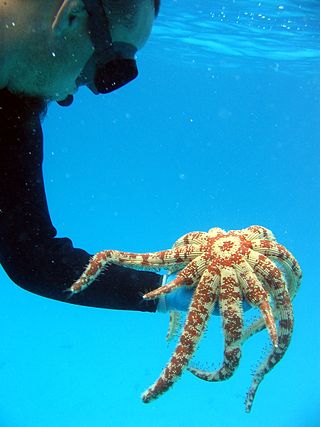
Luidia is a genus of starfish in the family Luidiidae in which it is the only genus. Species of the family have a cosmopolitan distribution.
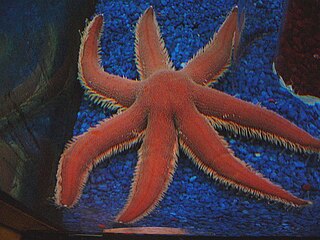
Luidia ciliaris, the seven-armed sea star, is a species of sea star (starfish) in the family Luidiidae. It is found in the eastern Atlantic Ocean and the Mediterranean Sea.
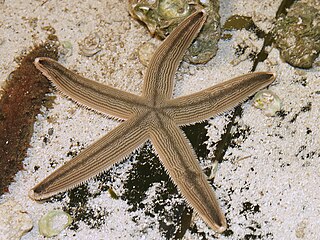
Luidia clathrata is a tropical species of starfish in the family Luidiidae. It is variously known as the slender-armed starfish, the gray sea star, or the lined sea star. It is found in the western Atlantic Ocean.

Luidia magnifica, the magnificent star, is a species of starfish in the family Luidiidae. It is found in the Pacific Ocean.
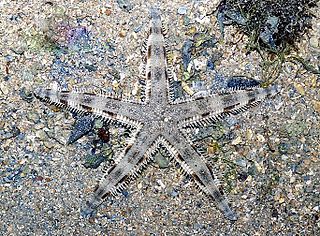
Archaster typicus is a species of starfish in the family Archasteridae. It is commonly known as the sand star or the sand sifting star but these names are also applied to starfish in the genus Astropecten. It is found in shallow waters in the Indo-Pacific region.

Evasterias troschelii is a species of starfish in the family Asteriidae. Its common names include the mottled star, false ochre sea star and Troschel's true star. It is found in Kamchatka and the north western coast of North America.

Luidia senegalensis, the nine-armed sea star, is a tropical species of starfish in the family Luidiidae found in the western Atlantic Ocean.

Luidia foliolata, the sand star, is a species of starfish in the family Luidiidae found in the northeastern Pacific Ocean on sandy and muddy seabeds at depths to about 600 m (2,000 ft).

Ophiura albida is a species of brittle star in the order Ophiurida. It is typically found on the seabed in the north eastern Atlantic Ocean and in the Mediterranean Sea and is sometimes known as the serpent's table brittle star.

The spiny sand seastar is a species of starfish in the family Luidiidae. It is found in shallow parts of the China Sea and in the vicinity of the Korean archipelago. The tissues of this starfish have been found to contain several secondary metabolites with medicinal potential.

Luidia australiae, the southern sand star, is a species of starfish in the family Luidiidae. It is found in the Pacific Ocean around Australia and New Zealand.
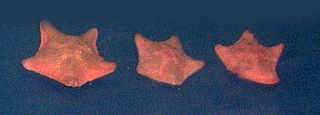
Asterina gibbosa, commonly known as the starlet cushion star, is a species of starfish in the family Asterinidae. It is native to the northeastern Atlantic Ocean and the Mediterranean Sea.
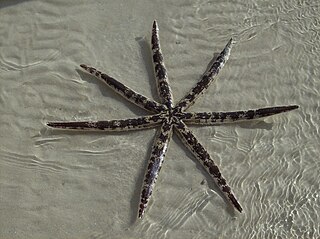
Luidia maculata is a species of starfish in the family Luidiidae in the order Paxillosida. It is native to the Indo-Pacific region. It is commonly known as the eight-armed sea star because, although the number of arms varies from five to nine, eight arms seems to be the most common.
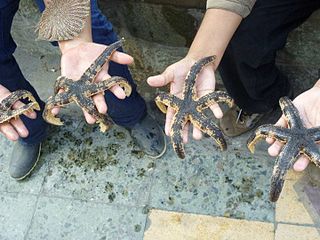
Luidia magellanica is a species of starfish in the family Luidiidae. It is found in the southeastern Pacific Ocean on the coast of South America.
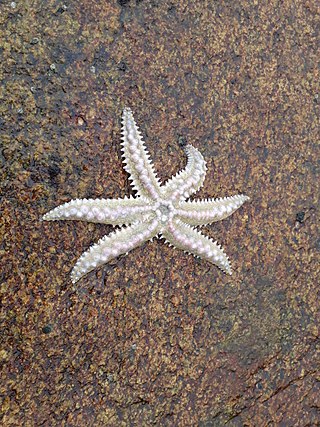
Meyenaster is a genus of starfish in the family Asteriidae. It is a monotypic genus and the only species is Meyenaster gelatinosus which was first described by the Prussian botanist and zoologist Franz Julius Ferdinand Meyen in 1834. It is found in the southeastern Pacific Ocean on the coasts of South America.
Asterias versicolor is a species of starfish native to the southern coasts of Japan southwards to the South China Sea.

Luidia savignyi is a species of starfish belonging to the family Luidiidae. The species is found in the tropical and subtropical Indo-Pacific region. It is a large starfish and preys on other echinoderms.


















